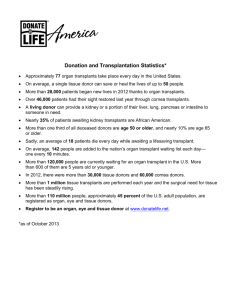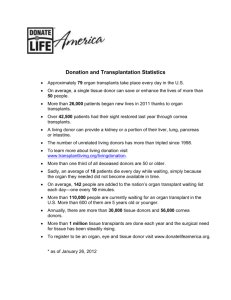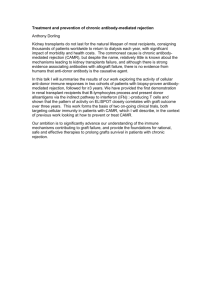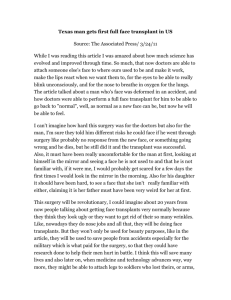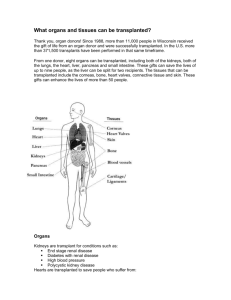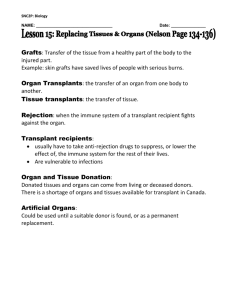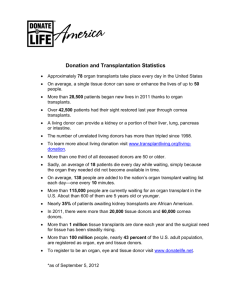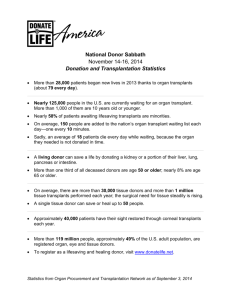Transcript for "Transplantation and the Eye"
advertisement
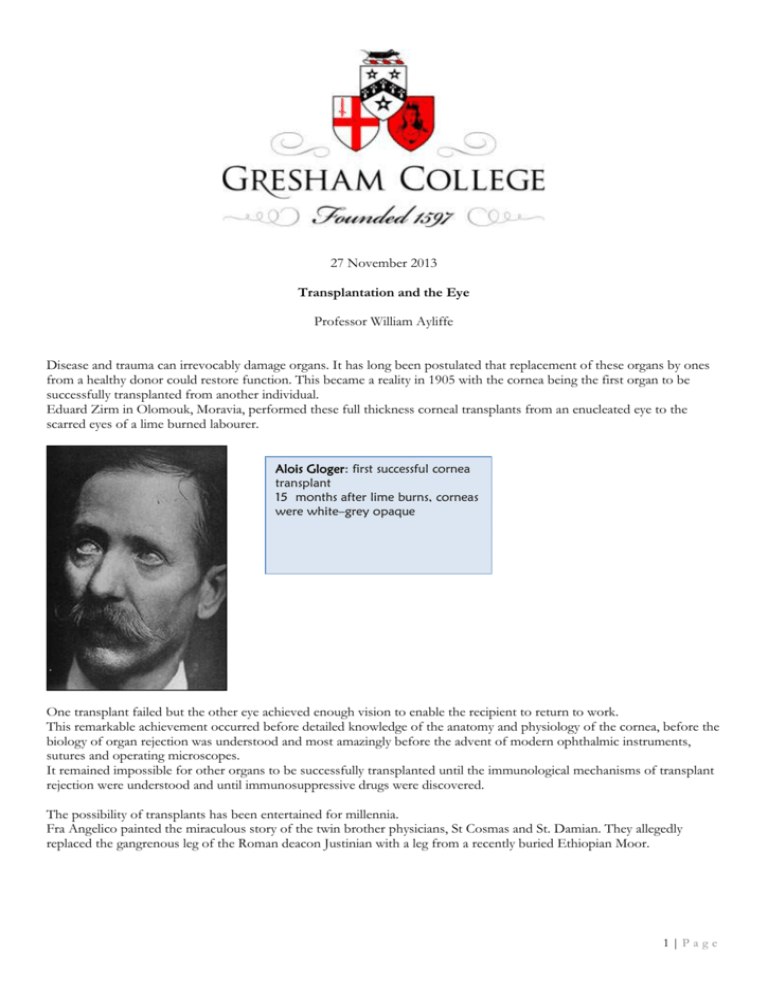
27 November 2013 Transplantation and the Eye Professor William Ayliffe Disease and trauma can irrevocably damage organs. It has long been postulated that replacement of these organs by ones from a healthy donor could restore function. This became a reality in 1905 with the cornea being the first organ to be successfully transplanted from another individual. Eduard Zirm in Olomouk, Moravia, performed these full thickness corneal transplants from an enucleated eye to the scarred eyes of a lime burned labourer. Alois Gloger: first successful cornea transplant 15 months after lime burns, corneas were white–grey opaque One transplant failed but the other eye achieved enough vision to enable the recipient to return to work. This remarkable achievement occurred before detailed knowledge of the anatomy and physiology of the cornea, before the biology of organ rejection was understood and most amazingly before the advent of modern ophthalmic instruments, sutures and operating microscopes. It remained impossible for other organs to be successfully transplanted until the immunological mechanisms of transplant rejection were understood and until immunosuppressive drugs were discovered. The possibility of transplants has been entertained for millennia. Fra Angelico painted the miraculous story of the twin brother physicians, St Cosmas and St. Damian. They allegedly replaced the gangrenous leg of the Roman deacon Justinian with a leg from a recently buried Ethiopian Moor. 1|Page In reality such transplants would not survive due to failure of vascularization and rejection. The understanding of rejection was a process that took two centuries of clinical observation and brilliant experimentation, leading to the award of several Nobel prizes. The specific memory of the body to infectious organisms was well known and was used by Jenner to develop vaccination to smallpox. It was 100 years later before it was realised that the same memory system was involved in causing rejection of foreign tissue transplants. Georg Schöner in 1912 summarized the experimental work with animal skin transplants and coined the term “Transplantationsimmunitat” In fact the extraordinary powerful mechanism of the immune system to cause rejection had prevented the use of allografts, that is transplants from one individual to another. However, autografts, from one part of the body to another part of the same person were commonplace. For small wounds such as replacing noses these could often be successful. The ancient Indian technique of reconstructing noses became widely known after the anonymous publication in the gentleman’s Magazine of 1793, recording the observation of this operation by two surgeons of the British Residency in Poona. An earlier unpublished account had come back to Europe with Nicolò Manuzzi (1638-1717) who had accompanied the British diplomatic visit to India by viscount Bellomont. Certainly a thriving local business of repairing noses was well established in Sicily, and reporting these observations, Gaspare Tagliacozzi (1545-99) of Bologna became famous. 2|Page Morbus Gallicus: Albrecht Dürer (1496). Earliest depiction of the disease: Wears clothes of Landsknechten, Mecenary soldiers. In November 1484, Saturn and Jupiter met in Scorpio: It was thought the disease was caused by this unfavourable planetary alignment The French disease or Pox was yet to be named Syphilis. The 16th to 19th centuries were a bad time for faces and noses, not just because of war and judicial punishment, but also due to the emergence of veneral syphilis. This disease spread rapidly from its source in the French Italian wars, carried by soldiers to all corners of Europe. The infection led to ulcerating gumma that destroyed soft tissues eating them down to the bone and the face and nose created obvious areas where it wreaked its destruction. There was a need for cosmetic repair to mask the badge of shame such horrific injuries inflicted and a thriving market in prosthesis and surgical repair developed. These repairs were carried out using transplants from other areas of the body, either a local rotation flap from the forehead, in the Indian Rhinoplasty technique, or by pedicle grafts from the arm in the Italian version. Once healing had been established the flaps could be cut, moulded and shaped to reconstruct the face and nose of the victim. The graft having derived from the recipients own tissue could not be recognized as foreign and as long as an adequate blood supply developed the transplanted skin would survive. Burns were always a dangerous, mutilating and often life threatening injury. Luckily they remain rare in peacetime, although episodic bursts of injuries occurred with industrial accidents and transport crashes with steam powered engines. Their incidence and severity increased with warfare. In particular the development of aeroplanes and incendiary bombing of cities hundreds of cases of extensive and severe burns occurred. 3|Page This stimulated the need for skin transplantation, but often there was not enough undamaged skin to be safely moved to allow transplantation, and several of the early patients died after attempts at reconstruction. Flight Lt Harry Mount who was severely burned in a crash of his BE12 in July 1916. He died after having a large transplant raised to repair his face and eye sockets in March 1918. (courtesy Royal College of Surgeons). Clearly there was a need to develop transplants from human donors (allografts) or even from other species (xenografts). Peter Medawar was assigned to investigate the mechanism of allograft failure by the war commission. With clinical observations on burn victims in Glasgow and a series of experiments on Rabbits he established in Reports to the War Wounds Committee Journal of Anatomy 1944 and 1945. Mechanism by which foreign skin is eliminated is by actively acquired immune reactions. Animal learned to recognise the donor Developed memory Unrelated second donor no accelerated rejection The process is specific 4|Page Xenogeneic transplants invariably fail Allogeneic transplants usually fail There is an initial take of a first allograft which is then followed by rejection Second grafts undergo accelerated rejection if recipient has previously rejected a graft from the same donor or if recipient has been pre-immunized with material from donor Graft success is more likely when donor and recipient have a closer “blood relationship” Autografts are almost always successful Subsequent experiments showed the mechanism of rejection and memory resded with a subset of the inflammatory blood cells called LYMPHOCYTES. Injecting lymphocytes from a recipient who had rejected a graft transferred the memory of the donor to a naïve recipient! 5|Page Clearly the mechanism was under genetic control. Gregor Mendel had established that certain characteristics of plants were inherited in discrete packages. These packages were later named genes. One inherited from the female and one from the male parent. If these genes were identical in both parents then the characteristic (phenotype) of the offspring would be the same as the parent. However genes vary, and if one parent expresses a variation (allele) of the gene that is recessive then the offspring will develop the characteristic of the dominant gene. This enabled clear rules of inheritance to be formulated. However, most characteristics, such as eye or hair colour are not inherited as simple pairs of genes but as a complicated co-expression of a bunch of genes. This made it seem as if animals did not inherit phenotypes in a Mendelian fashion. Investigating this phenomenon in Castle’s laboratory at Harvard, Clarence Little stumbled upon the reason for transplant rejection. Little used his inbred mice. Malignant cells injected into same strain, grow vigorously and cause death. Injected into other strains, tumors would usually fade away, allowing survival. Rate of acceptance 100% in parental strain, 100% in the F1 generation, 1.6% in the F2 generation. 1916 calculated that there were approximately 12 genes responsible for cancer resistance He accidentally discovered that large number of histocompatibility loci determine the acceptance of allogeneic tissues (tumours) 6|Page Snell at Little’s laboratory in Maine and Peter Gorer in London extended this work and identified the Major Histocompatibility Complex genes, which coded for proteins intimately involved with recognizing foreign infections but were equally as good at recognizing foreign tissue grafts. Corneal tissue did not reject as readily as tissue from other organs due to a phenomenon called immune privilege. Nevertheless, the commonest cause for cornea graft failure is rejection and the post immunosuppressive drug world eye transplants fared less well overall than other organ grafts. Transplants are needed to restore eyesight into those injured by chemicals or infection and to repair opacities and shape changes caused by disease. The whole cornea is not routinely transplanted. Surgeons evaluate the part of the cornea that is diseased and then deliberately transplant just the bit that is affected (lamellar transplants). If the front part of the cornea is affected then a Deep Anterior Lamellar Keratoplasty (transplant) is performed. 7|Page The cornea is disected layer by layer to expose the Descemet’s membrane onto which the donor cornea is secured with a single almost invisible 10/0 nylon suture. For disease of the single cell interior lining of the cornea (endothelium) an endothelial keratoplasty is required. An ultrathin sheet of tissue bearing the delicate single-cell layer sheet from the donor is carefully scrolled up and injected in the eye before being positioned using a temporary air bubble. No sutures to the graft are required. 8|Page An endothelial transplant in a patient who previously needed multiple reconstruction surgeries including tectonic peripheral grafts to stabilize the eye, dense white cataract removal and an iris prosthesis. Corneal transplantation saves eyesight, but it requires you the public to donate your eyes after death. People of all ages can donate corneas and about 65% of cornea-only donors are over 60 years old join the NHS Organ Donor Register by calling 0300 123 23 23 or visiting the NHSBT website www.organdonation.nhs.uk THANKS TO MY PATIENTS AND TO MY COLLEAGUES FOR THEIR REFERRALS © Professor William Ayliffe, 2013 9|Page
